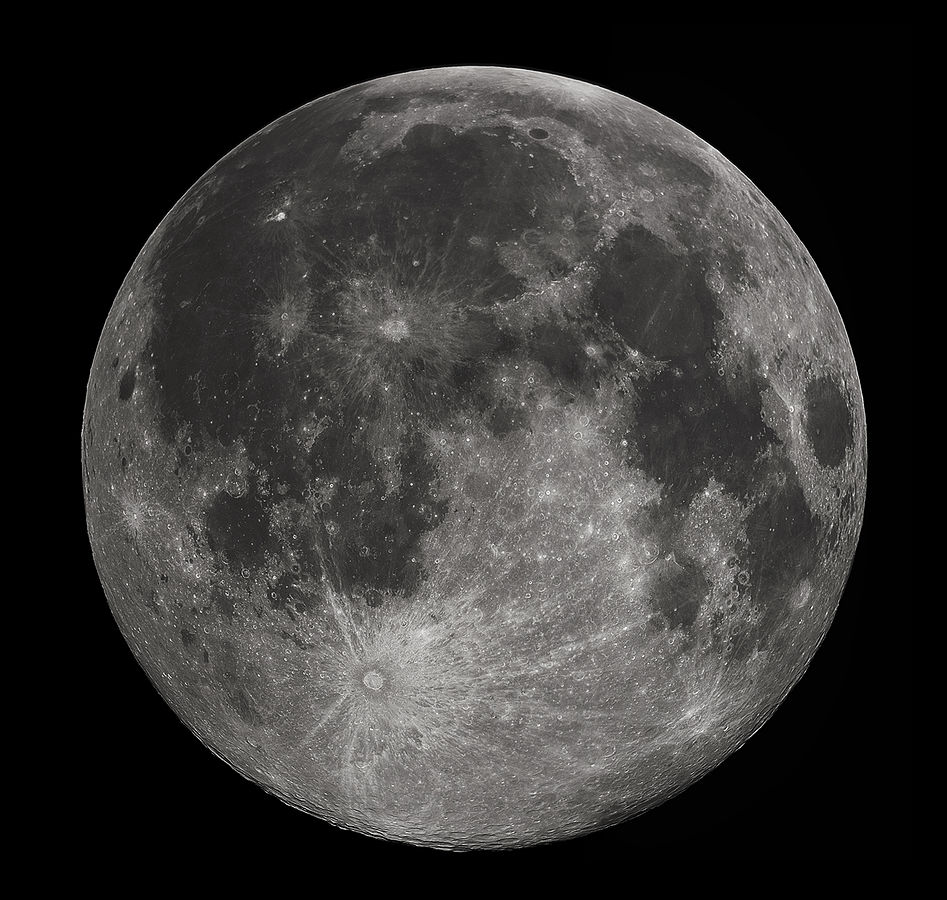GAM 2018 Blog
- Published: Monday, April 02 2018 17:00
-
 Tilly Evans
Tilly Evans
By Monica Young
|
The theme for this year’s Global Astronomy Month is the Moon. No wonder! The Moon is often the first thing a toddler recognizes in the night sky, yet its ancient history draws in skywatchers with many years of experience under their belts. This simple orb embodies incredible layers of complexity and contradictions — let’s look at a few of them. 1. Bright vs. DarkThe full Moon lights up our night skies, blocking out all but the brightest stars — in fact, it’s so blindingly bright through a telescope, you’re best off using a polarized filter lest you kill your night vision for the evening. But that’s the Sun’s brilliance we see — the surface of the Moon is actually a dark gray, more like aged asphalt than shining white. |
 The full Moon appears blindingly bright through a telescope, but it's actually a dark gray, reflecting only 12% of the Sun's light. Credit: Gregory H. Revera |
|
The surface of the Moon embodies the same night-and-day opposition — crater walls near its poles, dubbed “peaks of eternal light,” rarely miss sunlight. But permanently shadowed crater floors, also near the poles, are shielded from the Sun forever. (And they might hold millions of metric tons of ice as a result.) 2. Good vs. EvilPerhaps it's no coincidence that the mythology and symbolism of the Moon portray the same conflict. The Greek goddess Artemis and her Roman equivalent Diana are virgin huntresses who represent the Moon, making it a beacon of purity. But the moon is just as often associated with lunacy, werewolves, and “trouble on the way.” 3. Changing vs. ConstantThe Moon embodies opposites so well in part because it’s always changing: From the new Moon, to waxing crescent, full Moon, and waning gibbous phases, the Moon graces our evening, midnight, and dawn skies. Its regularity is so dependable that the world’s ancient calendars were based on its cycles. In fact, the word “moon” derives from Indo-European roots meaning "month" and "measure". The Moon has been Earth’s constant companion since its earliest days. A recent theory suggests that a Mars-sized body slammed into Earth when it was only 100 million years old, turning our rocky planet into a terrestrial synestia, a molten, spinning, donut-shaped mass. Eventually, this hot mass cooled and separated into the Moon and Earth. This amazing origin would explain why the Moon is made of the same stuff as Earth, even having the exact same isotopic ratios (e.g., oxygen-16 to oxygen-14). Since it formed all those 4.5 billion years ago, the Moon’s surface has changed remarkably little: most of the craters we see on its surface are well over a billion years old. Tycho, one of the Moon’s largest and most recognizable craters is an interesting exception: Astronauts brought back rocks sampled from this craters’ rays, which indicate its age is about 100 million years old. Still, the arid lunar landscape is nearly changeless — those astronauts’ boot prints will long outlive their makers. 4. Life vs. Magnificent DesolationThe most crucial difference between Earth and its companion is, of course, life. Earth supports luscious greenery, while the Moon exists in what Buzz Aldrin called “magnificent desolation.” For many years, astronomers clung to the idea that certain shapes and flickers they saw through their telescopes signified lunar civilization. But better observations and, eventually, boots on the ground proved otherwise. In a sense, the Moon represents everything the Earth is not: it cannot support an atmosphere, global magnetic field, plate tectonics, running water, or life. Yet because of that, the Moon displays on its surface what Earth has hidden from view: a record of the history of the solar system. As you explore the Moon this month, keep in mind: there’s much more to Earth’s companion than first meets the eye. |
|
|
Dr. Monica Young earned her Ph.D. researching the behavior of supermassive black holes in distant galaxies. In 2012, she joined the talented team at Sky & Telescope, where as News Editor, she edits, writes, and commissions news stories and magazine feature articles. |
 |








